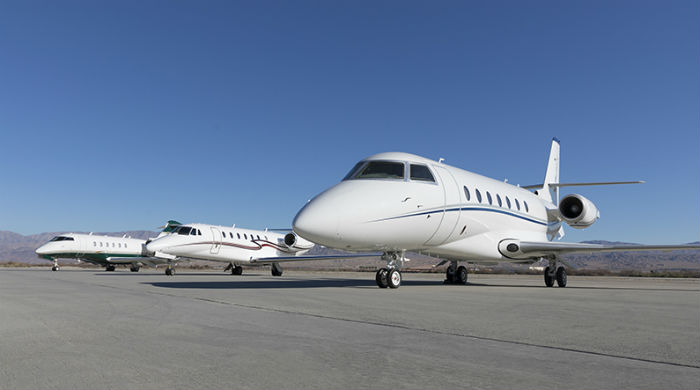Cut-priced charter rates impacting market sustainability

Desert Jet mid-size charter fleet
Global charter activity is showing signs of recovery as it emerges from global lockdown which means good news headlines for the industry. However, flight activity does not equate to profitability – many charter operators have been slashing prices in an effort to ensure cashflow as the impact of Covid-19 travel restrictions began to bite. Industry insiders warn that cut prices are not sustainable and doing so means Autumn will be a very telling time for some charter operators as bills begin to arrive and flying begins to wane.
We are becoming accustomed to headlines confident of the industry’s ongoing recovery. It is true that European activity is up 70% since the beginning of June and in the US 20%, according to WINGX data. Operators are benefitting from an influx of new customers, not just window shopping, now flying private. PrivateFly has seen a switch from a traditional 25:75 new and returning client split to now seeing 65% in new custom. Also, FlyVictor told Corporate Jet Investor it has seen a 35-40% rise in new clients, a first for the company.
The question remains, how sustainable can the market be in its current state? Adam Twidell, CEO, PrivateFly told Corporate Jet Investor not very. “Those [operators] that are flexible are doing well. There has been a price war taking place. Some aircraft operators are just not prepared to lower their price and others are.”
He believes capturing new customers will be pivotal in giving an easier ride the challenging market conditions, which lie ahead. “There is no industry averaging going on, it is very lumpy, some operators are flying at near normal levels whilst others are virtually grounded. The danger sign is when an operator needs to fly for cash flow. It’s clearly not sustainable unless an aircraft owner is happy to fly at cost or just under.”
Justin Bowman, CEO, Air Charter Service (ACS), too has fears over the sustainability of current trends emerging within charter. While hopeful that new customers are here to stay, on the flip side he said there is pent up demand from existing clients being felt at present.
Bowman told CJI he had seen prices dropping in May: “Rates were lower than they were usually and that was because there was an element of desperation amongst some operators – paying for crews, paying for airplanes, for finance – to get some contribution to their costs. Particularly we saw in North America, some of the operators that we would normally consider to be at the upper end of the price spectrum were offering much more reasonable prices, because with large fleets they were just desperate to bring cash in the door.”
Bowman continued: “But as we have gone into June the market has been clearly strengthening in Europe and North America. That over supply which we saw in May which drove the prices down has now almost dissipated and I would say prices are, broadly speaking, now at what I would call a normal level.”
A silver lining is illuminating in the ultra-long range division, however. Steve Varsano told last week’s CJI Town Hall meeting that corporates were not flying private and this was impacting the industry’s recovery. Yet some organisations, such as mining and oil companies, cannot simply download Zoom and work from home.
Graham Williamson, president, ACASS Ireland, which only received its AOC in mid-April, told CJI the company’s average sector length for a Challenger 605 is four hours and 20 minutes when he would assume it to be around the three-hour mark. “We are going down to Ghana, to Mauritania, we are going to India, Cancun and Colombia. Virtually all of those are moving essential staff for corporates. So, niche we have fallen into as with the demise of scheduled services we are being exposed to new potential business and that clearly is a long term benefit I think.”
The caveat however, Williamson said, is that operators with smaller fleets will find it easier, but you still have to be creative and utilise the relationships you have within the industry in order to thrive.
In terms of the sustainability of lower pricing Williamson said it depends how low you go but it cannot be sustainable in the long term. He said operators now flying to ensure cash flow can do so in the short term. “If you were to start today with an aircraft for charter and you did [£]400,000 in revenue then you wouldn’t actually start spending that money until the following month [when the bills come in]. In other words, keeping cash flow going is probably quite important to those operators with bigger fleets. When the music stops, it’s going to get tough. There could come a month where you didn’t get the revenue you need but you’re paying all of last month’s bills when you did a lot of flying
“And that is going to be October or November. So, what you do now is just accrue, don’t spend and wait for a rainy day, which I’m sure they will be.”








